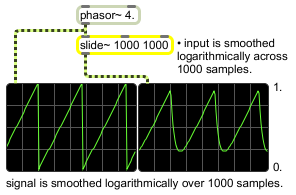Examples

slide~ performs logarithmic smoothing of an input signal
Filter a signal logarithmically
| Name | Type | Opt | Description |
|---|---|---|---|
| slide-up | float | opt | Specifies the slide up value. The default is 1. (Also accepts integers for these arguments as well as the associated messages which address these parameter settings.) |
| slide-down | float | opt | A second argument specifies the slide down value. The default is 1. (Also accepts integers for these arguments as well as the associated messages which address these parameter settings.) |
| int | current-output-sample [int] |
Sets the current output sample value (the value from which the next incoming value will smoothly transition from). |
| float | current-output-sample [float] |
Sets the current output sample value (the value from which the next incoming value will smoothly transition from). |
| (inlet1) | slide-up [float] |
In middle inlet: Specifies the slide up value to be used when an incoming value is greater than the current value. |
| (inlet2) | slide-down [float] |
In right inlet: Specifies the slide down value to be used when an incoming value is less than the current value. |
| signal | A signal to be filtered. Whenever a new value is received, slide~ filters the input signal logarithmically between changes in signal value using the formula: y (n) = y (n-1) + ((x (n) - y (n-1))/slide) A given sample output from slide~ is equal to the last sample's value plus the difference between the last sample's value and the input divided by the slide value. Given a slide value of 1, the output will therefore always equal the input. Given a slide value of 10, the output will only change 1/10th as quickly as the input. This can be particularly useful for lowpass filtering or envelope following. |
|
| slide_down | slide-down [float] |
The message followed by a float will specify the slide-down value to be used when an incoming value is less than the current value. |
| slide_up | slide-up [float] |
The message followed by a float will specify the slide-up value to be used when an incoming value is greater than the current value. |
| reset | Sets the current output sample value to 0(the next incoming value will smoothly transition from that 0). |

| Name | Description |
|---|---|
| rampsmooth~ | Smooth an incoming signal |